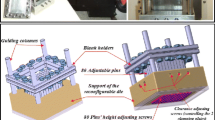Abstract
Among various incremental forming methods, two-point incremental forming (TPIF) is superior to single-point incremental forming (SPIF), but nonetheless, its flexibility is lower than SPIF. In this paper, in order to increase the flexibility of TPIF to form parts with free-form surfaces from an aluminum sheet, a supporting structure together with a reconfigurable multi-point die is implemented. The flexibility of TPIF process using the multi-point die is experimentally and numerically studied by forming a set of components comprising a hemisphere and free-form surfaces such as a scaled-down bulbous bow of a ship hull. The results showed that the proposed multi-point die has a high ability and flexibility in manufacturing of various symmetric and asymmetric components with different dimensions and geometries. In this regard, TPIF of a hemisphere using the rigid and presented flexible dies is experimentally and numerically compared. The results showed that the part formed using the multi-point die has an acceptable accuracy, but for improving the surface quality, the use of a rubber pad between pins and the aluminum sheet is inevitable. The effect of three different types of rubber and the influence of a polyurethane pad with three different hardness values on the thickness distribution and the dimensional accuracy were numerically studied. The results showed that the rubber type does not affect the minimum thickness, and the hemisphere produced using the natural and polyurethane rubbers has the highest and lowest dimensional accuracy, respectively. It was numerically shown that by increasing the hardness of the rubber pad, the minimum thickness and the dimensional accuracy are improved.
Similar content being viewed by others
References
Shamsari M, Mirnia MJ, Elyasi M, Baseri H (2017) Formability improvement in single point incremental forming of truncated cone using a two-stage hybrid deformation strategy. Int J Adv Manuf Technol:1–12
Lu H, Kearney M, Wang C, Liu S, Meehan PA (2017) Part accuracy improvement in two point incremental forming with a partial die using a model predictive control algorithm. Precis Eng 49:179–188
Hirt G, Ames J, Bambach M (2006) Basic investigation into the characteristics of dies and support tools used in CNC-incremental sheet forming, in Proceedings of the International Deep Drawing Research Group Conference, pp. 341–348
Attanasio A, Ceretti E, Giardini C (2006) Optimization of tool path in two points incremental forming. J Mater Process Technol 177(1):409–412
Lasunon O, Knight W (2007) Comparative investigation of single-point and double-point incremental sheet metal forming processes. Proc Inst Mech Eng B J Eng Manuf 221(12):1725–1732
Taleb Araghi B, Bambach M, Hirt G (2009) Comparison of some final part geometrical characteristics of cylindrical cups manufactured by deep-drawing and two-point incremental sheet forming. Key Eng Mater 410:355–363 Trans Tech Publ
Li J-c, Chong L, Zhou T-g (2012) Thickness distribution and mechanical property of sheet metal incremental forming based on numerical simulation. Trans Nonferrous Metals Soc China 22:s54–s60
Silva M, Martins P (2013) Two-point incremental forming with partial die: theory and experimentation. J Mater Eng Perform 22(4):1018–1027
Lu B, Fang Y, Xu DK, Chen J, Ai S, Long H, Ou H, Cao J (2015) Investigation of material deformation mechanism in double side incremental sheet forming. Int J Mach Tools Manuf 93:37–48
Moser N, Zhang Z, Ren H, Zhang H, Shi Y, Ndip-Agbor EE, Lu B, Chen J, Ehmann KF, Cao J (2016) Effective forming strategy for double-sided incremental forming considering in-plane curvature and tool direction. CIRP Ann Manuf Technol 65(1):265–268
Wang S, Cai Z, Li M, Lan Y (2012) Numerical simulation on the local stress and local deformation in multi-point stretch forming process. Int J Adv Manuf Technol 60(9):901–911
Zhang Q-F, Cai Z-Y, Zhang Y, Li M-Z (2013) Springback compensation method for doubly curved plate in multi-point forming. Mater Des 47:377–385
Peng H, Li M, Liu C, Fu W, Cao J (2014) Numerical simulation of multi-point forming accuracy for polycarbonate sheet. Proceedings of the Institution of Mechanical Engineers, Part E: Journal of Process Mechanical Engineering 228(2):87–96
Luo Y, Yang W, Liu Z, Wang Y, Du R (2016) Numerical simulation and experimental study on cyclic multi-point incremental forming process. Int J Adv Manuf Technol 85(5–8):1249–1259
Zareh-Desari B, Davoodi B, Vedaei-Sabegh A (2017) Investigation of deep drawing concept of multi-point forming process in terms of prevalent defects. Int J Mater Form 10(2):193–203
Panjwani D et al (2017) A novel approach based on flexible supports for forming non-axisymmetric parts in SPISF. Int J Adv Manuf Technol:1–15
Zhang H, Lu B, Chen J, Feng S, Li Z, Long H (2017) Thickness control in a new flexible hybrid incremental sheet forming process. Proc Inst Mech Eng B J Eng Manuf 231(5):779–791
Boudhaouia S, Gahbiche MA, Ayed Y, Giraud E, Salem WB, Dal Santo P (2017) Experimental and numerical study of a new hybrid process: multi-point incremental forming (MPIF). Int J Mater Form:1–13
Attanasio A, Ceretti E, Giardini C, Mazzoni L (2008) Asymmetric two points incremental forming: improving surface quality and geometric accuracy by tool path optimization. J Mater Process Technol 197(1):59–67
Ramezani M, Ripin Z, Ahmad R (2009) Numerical simulation of sheet stam** process using flexible punch. Proc Inst Mech Eng B J Eng Manuf 223(7):829–840
Wang S, Cai Z, Li M (2010) Numerical investigation of the influence of punch element in multi-point stretch forming process. Int J Adv Manuf Technol 49(5):475–483
Belhassen L, Koubaa S, Wali M, Dammak F (2016) Numerical prediction of springback and ductile damage in rubber-pad forming process of aluminum sheet metal. Int J Mech Sci 117:218–226
Mirnia MJ, Vahdani M, Shamsari M (2018) Ductile damage and deformation mechanics in multistage single point incremental forming. Int J Mech Sci 136:396–412
Author information
Authors and Affiliations
Corresponding author
Additional information
Publisher’s note
Springer Nature remains neutral with regard to jurisdictional claims in published maps and institutional affiliations.
Rights and permissions
About this article
Cite this article
Nourmohammadi, A.A., Elyasi, M. & Mirnia, M.J. Flexibility improvement in two-point incremental forming by implementing multi-point die. Int J Adv Manuf Technol 102, 2933–2952 (2019). https://doi.org/10.1007/s00170-019-03307-y
Received:
Accepted:
Published:
Issue Date:
DOI: https://doi.org/10.1007/s00170-019-03307-y




